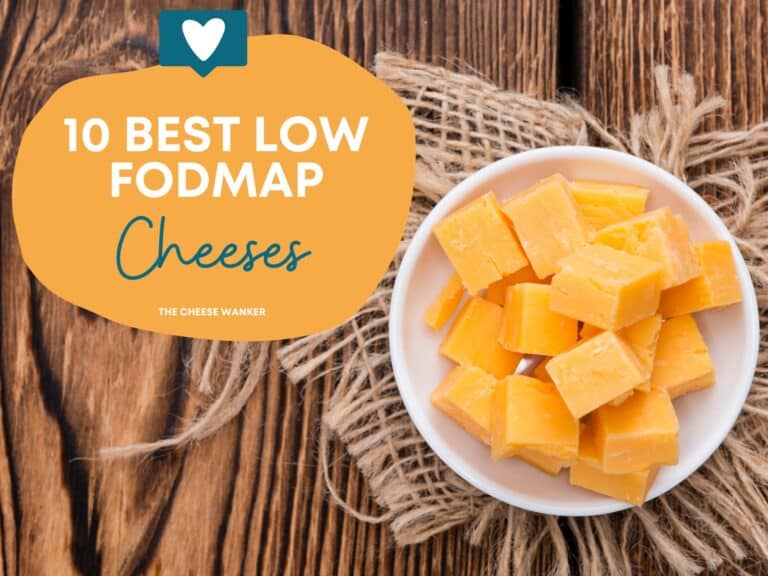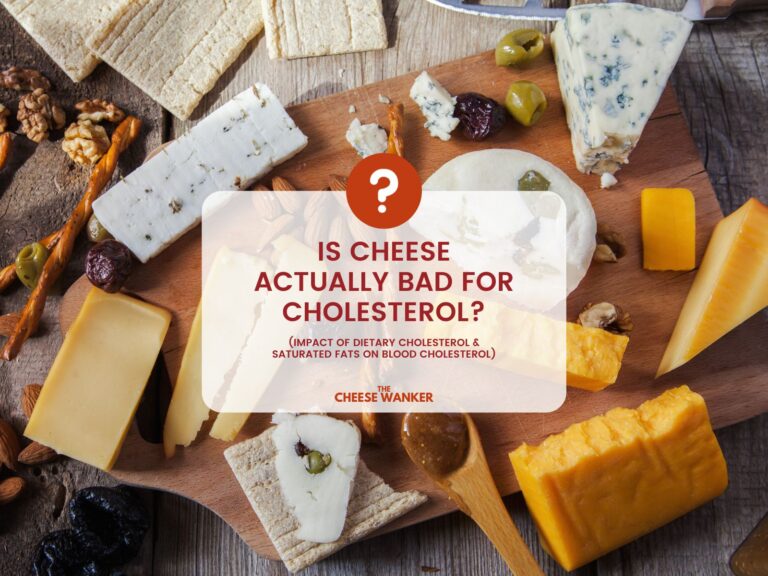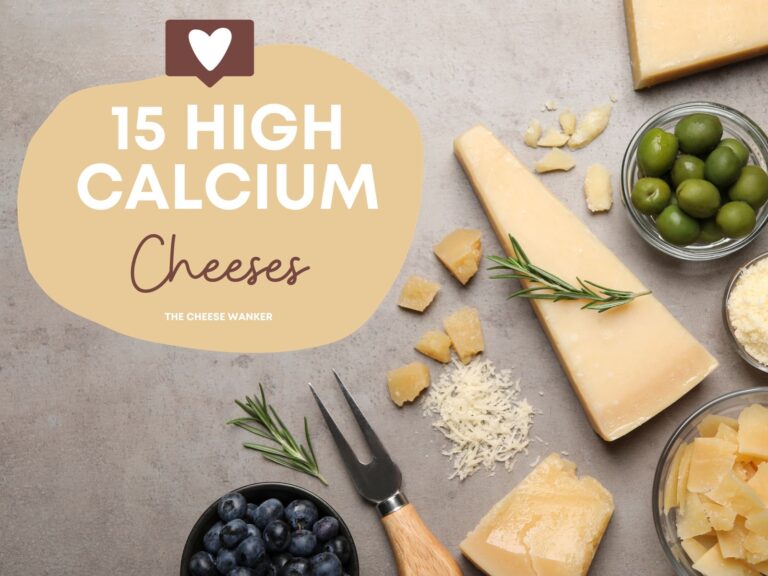As far as diets go, the ketogenic diet seems to be one of the most popular ones. And yes, cheese is a staple of this diet because of its fat content. But what are the best cheeses for a keto diet? Read on to discover our top 15.
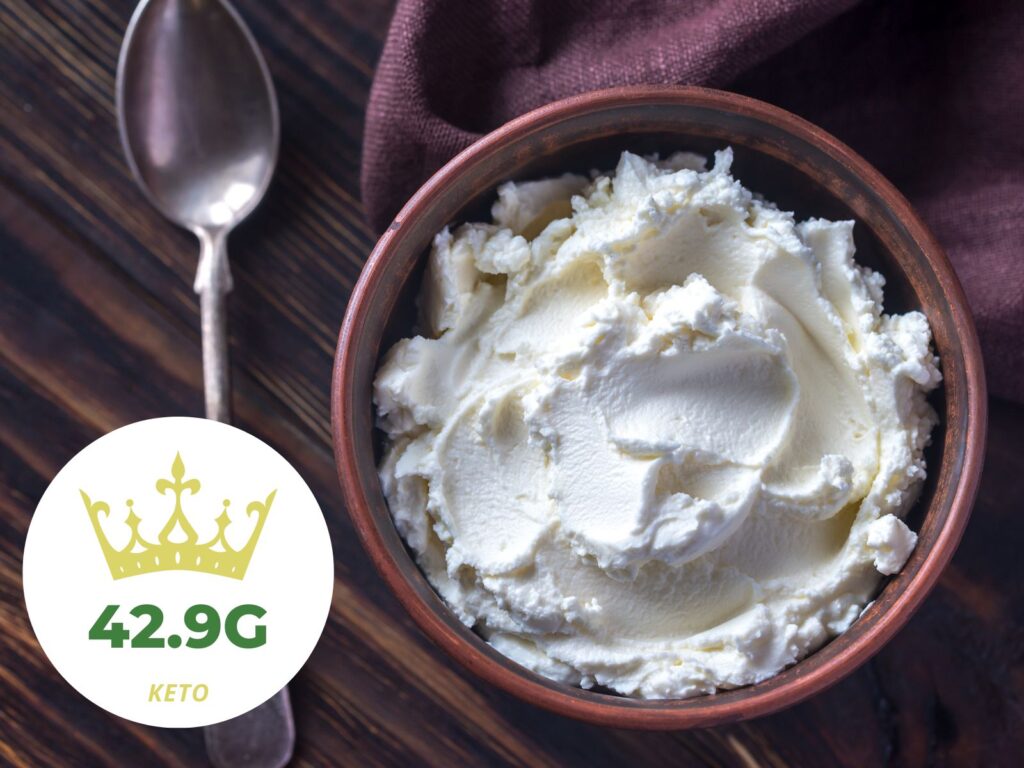
SEE ALSO: The Cheese Wanker’s archive of cheese nutrition facts →
What is a ketogenic diet?
The keto diet is a low carb, high fat diet often used to promote weight loss. Followers of the diet traditionally limit their carbohydrate intake to less than 50 grams per day to maintain ketosis. Ketosis is a state in which your body uses fat instead of carbohydrates as its main fuel source.
Because of this, some foods are better suited for the keto diet than others. As a general rule, cheese is a great keto food due to its high fat, moderate protein, and low carb content.
What type of fat is in cheese?
Well, most full-fat dairy foods contain a fairly high amount of saturated fats and some cholesterol. As a matter of fact, milk fat is about 70% saturated fat, 25% monounsaturated fat and 5% polyunsaturated fat². And, of course, this profile is maintained in the cheese that is made from said milk. You can read more about the types of fat in dairy products here.
Which cheeses can you eat when following a keto diet?
Unsurprisingly, the best cheeses for a keto diet are ones that have a high fat content and have undergone minimal processing. We’ve got some great examples for you below. For the purpose of this post, we have ranked the top 23 cheeses for keto by fat content (g/100g)¹.
Mascarpone (43 g)
Cream cheese does not get much more decadent than Italy’s Mascarpone. And when it comes to keto, this cow’s milk cheese reigns supreme at 42.9g of fat per 100g.
Mascarpone is a velvety Italian cheese known for its luxurious and creamy texture. Made from cow’s milk, it has a rich and buttery flavour with subtle hints of sweetness. Mascarpone is exceptionally smooth and spreadable, making it a versatile ingredient in both sweet and savoury dishes.
Mt Tam (42 g)
Mt. Tam cheese is a luxurious and creamy triple cream soft cheese hailing from California’s Cowgirl Creamery. Named after Mount Tamalpais, the cheese features a bloomy rind and a rich, buttery flavour that melts in your mouth.
It is made from organic, pasture-raised cow’s milk, resulting in a luscious texture and a slightly tangy finish. Mt. Tam cheese is a beloved artisanal delight that pairs perfectly with crusty bread, fruits, and a glass of wine.
Creamy Danish Blue (42 g)
Creamy Danish Blue is a decadent blue cheese originating from Denmark. It boasts a soft and creamy texture, along with a complex and tangy flavour profile. The cheese is characterised by its marbled blue veins that run throughout, contributing to its distinctive appearance and bold taste.
You can read more about the nutritional profile for Creamy Danish Blue here.
Brillat Savarin (38 g)
Brillat Savarin is a decadent and indulgent triple cream French cheese named after the renowned gastronome, Jean Anthelme Brillat-Savarin. It is exceptionally rich, smooth, and creamy in texture, owing to its high butterfat content.
This luxurious cheese offers a delicate and buttery flavour with hints of mushrooms and earthiness.
Bel Paese (36 g)
Bel Paese cheese is a semi-soft Italian cheese renowned for its mild and delicate taste. Its name translates to “beautiful country,” reflecting its origins. With a smooth and creamy texture, Bel Paese offers a subtle tanginess and a buttery flavour that is both approachable and enjoyable.
Like most of the cheeses on this list, Bel Paese has a very low carbohydrate content (less than 1% of the RDI).
Manchego (36 g)
Manchego is a sheep’s milk cheese originating from La Mancha, Spain. It has a firm texture and a nutty, slightly tangy flavour. You can enjoy this fatty Spanish cheese as a table cheese or in many traditional Spanish dishes.
Actually, laboratory testing on samples of Manchego reveal that it contains no detectable levels of carbohydrates. Like Mt Tam and Creamy Blue, this makes Manchego well suited to a keto diet.
Stilton (36 g)
Undoubtedly, Stilton is the UK’s most famous blue cheese. Originally from Nottinghamshire, this crumbly blue is a great table cheese but can also be used as an ingredient in salads and grilled cheese sandwiches.
Comté (36 g)
Level with Stilton we find Comté. This pressed cooked raw milk beauty originates from the Jura region of France. It has a nutty, sweet, and slightly savoury flavour and is commonly used in fondue, gratins, and on cheese boards.
Cheddar (34 g)
At 34 g of fat per 100g, we find the world’s most popular cheese, Cheddar. Originating from Somerset, England, Cheddar is available at a range of ages. And its flavour varies from mild and savoury to grassy and earthy. It is an exceptional ingredient for Mac & Cheese or a grilled cheese sandwich.
Beaufort (33 g)
Beaufort is a distinguished French cheese with a rich heritage. Crafted in the French Alps, this semi-hard cheese is made from raw cow’s milk and aged for a minimum of six months, resulting in a complex and robust flavour.
Beaufort showcases a smooth, firm texture with occasional small holes and a beautiful golden colour. Its taste is nutty, slightly sweet, and often exhibits hints of fruit and flowers.
Butterkäse (32 g)
Butterkäse, meaning “butter cheese” in German, is a semi-soft cheese that hails from Germany. True to its name, Butterkäse boasts a rich and buttery flavour that is both smooth and indulgent. Unsurprisingly, this comes down to its high fat content of 32 g per 100 g serving.
Moreover, its texture is creamy and slightly elastic, making it easy to slice and melt. The cheese has a pale yellow colour and a mild taste, with a delicate tang that adds a pleasant complexity.
Colby (32 g)
Colby cheese is a semi-hard cheese that originated in Wisconsin, USA. It is known for its mild and creamy flavour, making it a popular choice for those who prefer a milder cheese taste.
Colby has a smooth and springy texture, with a pale yellow colour. It is often compared to Cheddar, but it has a slightly softer and moister consistency. And it is marginally lower in fat (32 g vs 34 g per 100 g).
Boursin (32 g)
Boursin is a creamy and indulgent French fresh cheese renowned for its luxurious texture and rich flavours. Made from cow’s milk, Boursin cheese is soft, spreadable, and infused with a variety of herbs and spices.
It typically features a blend of garlic, herbs and black pepper, lending it a savoury and slightly tangy taste.
You can read more about Boursin’s nutritional profile in our comprehensive review here.
Halloumi (32 g)
Halloumi is a unique and versatile cheese originating from Cyprus. It is a semi-hard cheese with a distinctive characteristic—it has a high melting point, making it suitable for grilling or frying without losing its shape.
Halloumi has a slightly salty and tangy flavour, with a firm and chewy texture. When cooked, it develops a golden brown crust while maintaining a deliciously squeaky interior.
Havarti (32 g)
Finally, we have the second Danish cheese on this list, Havarti.
Havarti is a creamy and smooth cheese with a pleasant and mild flavour. This semi-soft cheese has a buttery and slightly tangy taste, with a hint of sweetness. It has a supple and elastic texture, making it easy to slice and melt.
Havarti is known for its small, irregular holes that contribute to its unique appearance. And its high fat content of 32 g per 100 g and low carb content (3.6 g per 100 g) make it an excellent choice for cheese lovers following a ketogenic diet.
Conclusion: cheese is awesome for keto!
Thank you for reading our post on the best cheeses for a keto diet. As you can see, there are a large number of fantastic cheeses that are high in fat and low in carbohydrates.
Some other great keto-friendly cheeses that narrowly missed out on our top 15 include Gouda, Pecorino, Red Leicester, Cambozola, Fontina, Edam and Gorgonzola.
Did I miss your favourite cheese? Drop me a comment below.
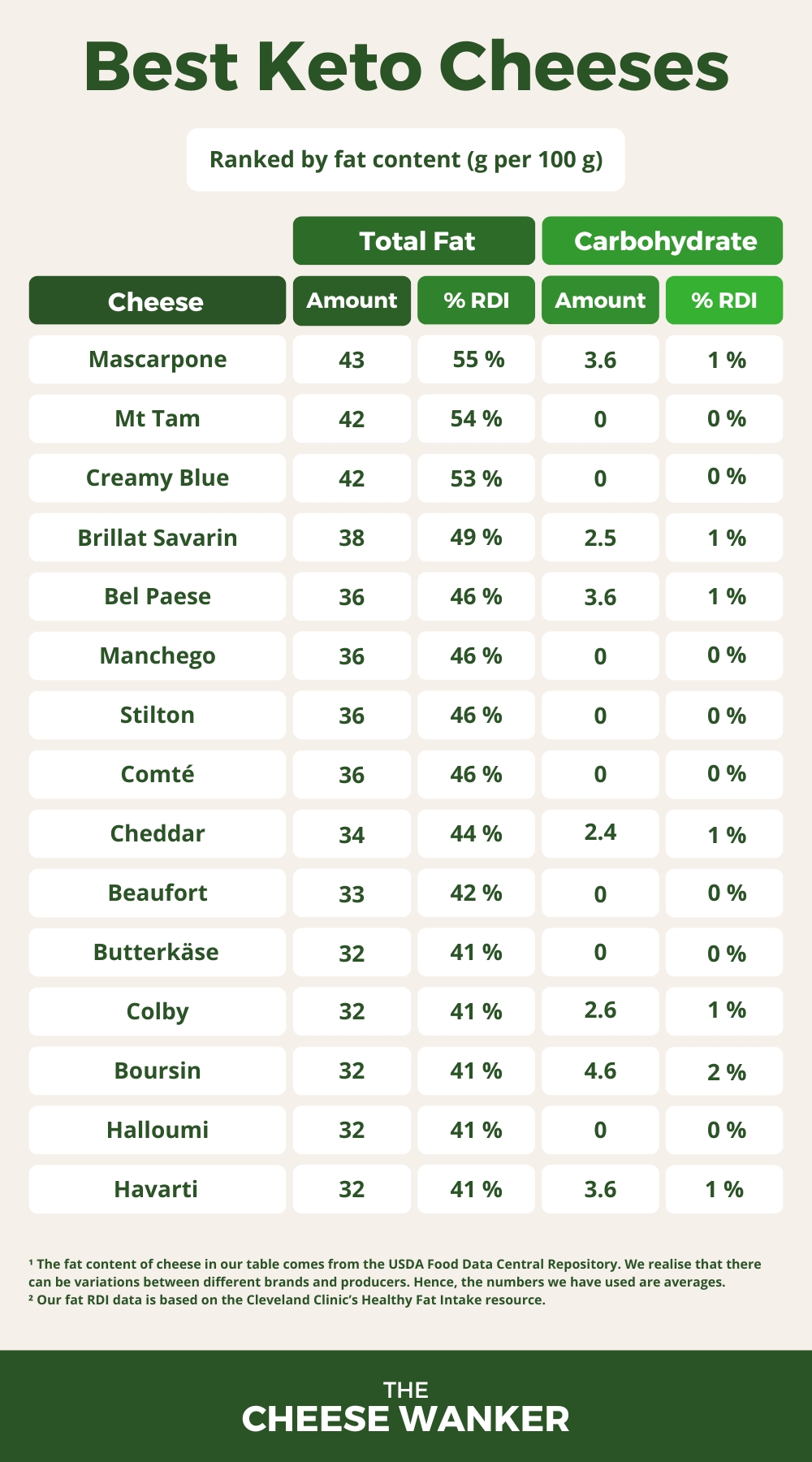
References
¹ The fat content of cheese in our table comes from the USDA Food Data Central Repository. We realise that there can be variations between different brands and producers. Hence, the numbers we have used are averages.
² Type of fat in cheese as per Harvard T.H. Chan’s The Nutrition Source.
